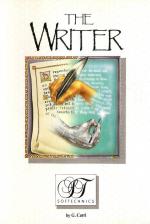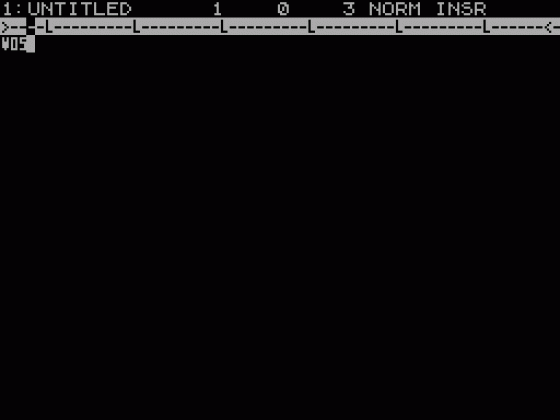
Sinclair User
 12th March 1986
12th March 1986
Categories: Review: Software
Author: John Gilbert
Publisher: Softechnics
Machine: Spectrum 48K/128K
Published in Sinclair User #50
The Writer
IF YOU despise the QL but are envious of the Quill word processor bundled with the machine, you can have the last laugh with your 128. QL owners can't use The Writer on their machines.
Softechnics has made its word processor one of the easiest to use but has made no concessions to features. It supports just about every action you would want to perform on a text document.
The Writer is supplied on cassette but it can be transferred to microdrive. If you're going to use it as a business too, microdrives or discs are a necessity. The drives reduce significantly the time taken for loading and saving text files, and when using the microdrive directory you can tell which files are available on a particular cartridge - a job which is almost impossible using the serial medium of cassette tape.

Once loaded the word processor goes automatically into insert mode. A status line at the top of the screen shows the optional microdrive number, the number of the page you are on, followed by the line and column positions of the cursor.
The main part of the screen contains the paper on which you write and the cursor blinks away at line zero, column zero. The page width is 63 characters but, if you own a printer which can print 80 or 100 characters per line, you can change the default and the screen will scroll across as you type.
The appeal of The Writer is mainly due to its drop down menus from which you can select most of the options available from the word processor. Selection is made using an arrow cursor and confirmed by pressing Enter. New commands can be given to The Writer in a few seconds while on other word processors finding the control keys may take up to half a minute.
Categories of sub-menu include: File, Edit, Text, Search, Format, Help.
The File menu allows you to manipulate external storage devices - cassette, microdrive and disc - change the name of a document, monitor the text as it is printed, change the storage medium and use mail-merge.
Five documents can be held in memory at the same time using the 128 RAM disc facility, so choosing a name for each using the File menu is important. If you do not set up names or values when required by The Writer, the program always puts its own default values into operation.
The Edit menu affects the way in which text is typed onto the screen and the way in which The Writer responds.
The Edit menu displays operations which can be performed on blocks of text. The block commands include Copy, Delete, and Write/Include. To Copy a block of text to another point of a document, mark the start and end points of the block with a graphics 'M' and invoke the command on the menu.
Delete is performed in a similar way and takes a block out of the document. You must be careful what you delete as - unlike The Last Word from Saga Systems - you will not be able to recover the text unless you have a back-up copy already saved.
Write/Include is used when you want to move text from one file to another. You could, for instance, create a number of separate files containing addresses using the Write option, produce a standard letter to send to a number of people, and then use the include option to place their names and addresses from backing storage, or RAM disc, into your current document.
The Write/Include option is more flexible than mail merge. You may have an almost standard letter, to be sent to several people, but with a different paragraph in each document. Just put the paragraphs into separate files and use the include option to print different versions of the letter.
The Text menu defines the way in which text is put on the screen, together with margin and tabulation settings. Text can be centred, ranged or justified. Most text is ranged to the left which means that each line starts flush with the left margin. If you set 'range right', however, each line is set flush with the right margin.
Alternatively, you could justify the text in your document. Spaces are introduced into each line of text so that it fills the space between the left and right margins.
On some occasions, the computer is unable to place a word at the end of a line and a decision is required from you The word can either be split in two or you can invoke word wrap. If that word cannot be split, it is wrapped onto the next line and the previous line spaced to take in the gap.
The final option on the Text menu is Tabs which makes tables and columns of figures easier to design. A tabulation mark is a point to which you can move the cursor on a line of text. For instance, if you are typing out columns of figures, you can set The Writer to skip to the start of each column.
There are three types of tab setting; left, right and centred. The default tab setting is left. The tab marks are shown by an 'L' inserted in a line at the top of the screen. Pressing Break will send the cursor to the first tab setting on a line.
Right tabulation is different only in the way in which text is put onto the screen. When you start typing, the cursor remains over the tab mark and text moves towards the left margin, making each column right-justified. Central tabulation is, again, similar but the cursor stays where it is, and text moves out left and right to centre the heading or figures in the column.
The Search and Replace facility - which takes the cursor to a specified part of a document - finds the start of any word or phrase you want to locate within that document.
You may call a member of your staff Mr Lewis but want to change every reference to him to Andrew Lewis. just type 'Mr Lewis' when asked what the search key is and the text with which you want to replace it.
The Format menu allows you to set up page numbers at the top or bottom of each page. You can print them in numeric, roman and alphabetic form but the default is numeric.
The Help facility is one of the most comprehensive of any Spectrum word processor, and works in a similar way to that provided with Quill on the QL.
You can obtain information on control keys, options which are available on a pull-down menus, control characters, installation, mail merge and communications. Each Help block is loaded independently from microdrive and usually contains two or three pages of information.
The main criticism of Help is that you must page all the way through a block of information. The only way to break out of the Help system when it's providing information is to crash the program and type RUN - that will get you back to the file you are editing.
The Writer can handle documents from several sources, for instance, text files from Wordstar - a word processor which is compatible with the IBM PC, and computers which run the CP/M operating system - even the QL.
The package contains a separate routine with which you can set up communication channels. You can send and receive ASCII. The Writer and Wordstar files from tape, microdrive, disc or RS232. The RS232 link means you can link up several computers and share files between them. That gives The Writer a leading edge over all the Spectrum word processors available.
The communications routine, with its drop-down menu control system, is easy to use and you do not have to fumble around with program code to get printers and interfaces to work together.
A printer configuration package is also included with The Writer which makes the program compatible with Interface 1, Kempston, Hilderbay and Euroelectronics printer interfaces.
A wide range of type faces - including italic, bold, and double-sized - can be incorporated within your documents, and printed using Epson, Custom, Diablo and H80 printers. You can also build your own printer driver by answering a series of questions posed by the computer - all very easy to follow.
The Writer is one of the most complex word processors on the market for any machine, but the use of pull-down menus and the extensive Help facility makes it one of the easiest to use.
Softechnics can be justifiably proud of itself. The Writer not only has the standard features but many extras. Reviewing this program was like taking part in an exploration of the many ways you can present the printed word. It was an education.
John Gilbert
Publisher: Softechnics Price: £17.95 Memory: 128K
*****
Other Reviews Of The Writer For The Spectrum 48K/128K
The Writer (Softechnics)
A review by Dominic Handy (Crash)
Word Wrap
Tasword II is the undisputed king of Speccy word-processing. Now it's got serious rivals courtesy of Softechnics The Writer and OCP's Word Manager. Max Phillips tries the challengers...
The Writer ()
A review
The Writer ()
A review by Graham Taylor (Sinclair User)











